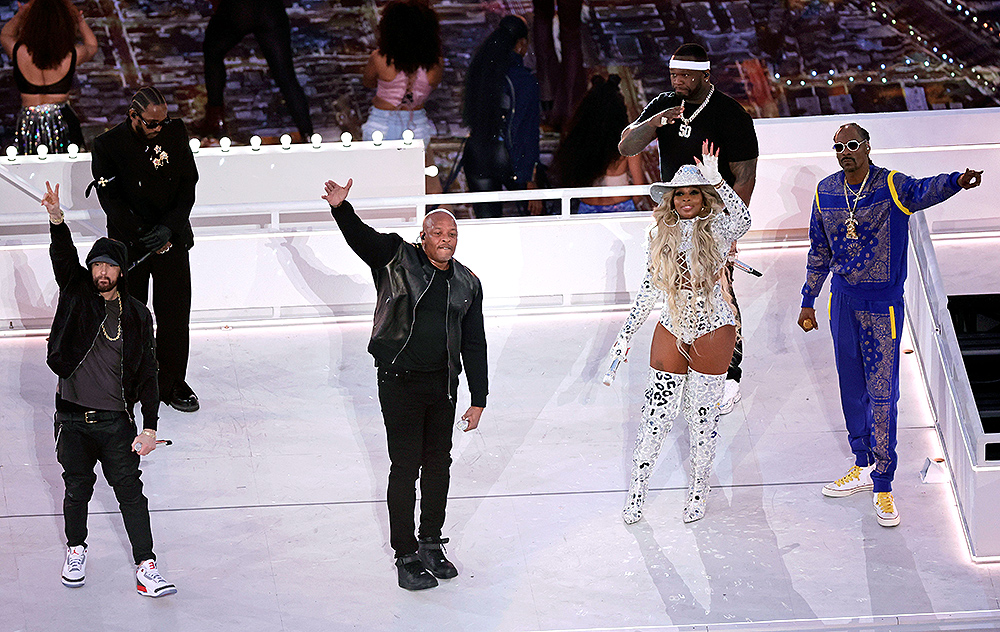
Mandatory Credit: Photo by Adam Hunger/AP/Shutterstock (12813152ex) Eminem, left to right, Kendrick Lamar, Dr. Dre, Mary J. Blige, 50 Cent and Snoop Dogg perform during the Pepsi Halftime show during the NFL Super Bowl 56 football game between the Los Angeles Rams and the Cincinnati Bengals, in Inglewood, Calif Rams Bengals Super Bowl Football, Inglewood, United States - 13 Feb 2022
Audience
- Sentiment: Mixed
- Political Group: Liberal
- Age Group: 18-34
- Gender: All genders
Overview
- Kendrick Lamar’s unexpected halftime show included a Sudanese-Palestinian flag, sparking discussion on political expression during entertainment.
- The reveal was unplanned, leaving organizers and viewers surprised and divided in their reactions.
- The incident raises questions about freedom of speech and the appropriateness of political messages in entertainment settings.
The Surprising Moment at the Super Bowl Halftime Show: A Flag and a Message
Imagine it’s a Sunday evening in February, the kind of night when people gather around the TV, snacks in hand, pumped up for the biggest football game of the year — the Super Bowl! The halftime show is just as big as the game itself, often featuring world-renowned artists performing dazzling displays of music and dance. This year, Kendrick Lamar took center stage, bringing his powerful messages through hip-hop to millions watching across the globe. But amidst the electrifying performances, something unexpected happened that caught everyone’s attention.
During the show, a performer revealed a flag that had “Sudan” and “Gaza” boldly written on it. This wasn’t just any flag; it was a Sudanese-Palestinian flag, and it was totally unexpected. The moment was so sudden that it took not just the audience but also the organizers completely by surprise. Picture this: you’re watching an epic performance, and suddenly, a performer bursts forth with a message that’s not rehearsed! The NFL and Roc Nation, the company that produced the show, later said that they had no idea this was coming. They confirmed that the act was not a part of the planned performance and that even the audience hadn’t been clued in on what was about to happen.
What does it mean when a performer chooses to reveal a political statement during such a high-profile event? And why did this person decide to share a message about Sudan and Gaza at the Super Bowl, of all places? Let’s dive deeper into this surprising moment and explore the potential meanings behind it.
The Power of the Super Bowl Halftime Show
First, it’s important to understand the Super Bowl halftime show’s significance. This isn’t just a break for halftime snacks; this part of the game is a spectacle watched by millions, often drawing larger viewer numbers than the game itself! Artists like Michael Jackson, Beyoncé, and Shakira have performed in the past, turning the halftime slot into a stage for not just entertainment but also cultural commentary.
When a performer steps onto that stage, they have the opportunity to reach an audience that stretches far beyond the football fans. It’s a chance to share their art, their voice, and in this case, their message. This is where our performer entered the narrative, making a bold statement in front of millions. In many ways, what they did was incredibly brave; they chose to use that moment to highlight serious issues affecting people in Sudan and Gaza, places that many people around the world may not think about often, especially during a sports celebration.
Understanding the Context: Sudan and Gaza
To grasp why this flag might carry so much weight, it’s essential to understand what Sudan and Gaza represent in today’s world. Sudan is a country in East Africa that has faced years of conflict and instability, a place that has seen everything from civil wars to famine. Meanwhile, Gaza is a densely populated area that has been significantly impacted by ongoing conflict and humanitarian crises. The struggles of the people in these regions are very real, and for the performer to highlight them on such a significant stage was a powerful reminder of the issues that people are facing every day.
By revealing this flag during the halftime show, the performer highlighted a call for awareness and solidarity with those affected by conflict and hardship in these regions. It’s like sending a message in a bottle but doing so in front of a global audience! It begs the question: In our fast-paced lives, are we often too absorbed in entertainment to pay attention to the serious issues that surround us?
The Reaction
The unexpected act created a variety of reactions. While some viewers saw it as a bold and necessary statement, others were shocked or outraged. Could it be seen as an inappropriate moment to bring in political messages? After all, not everyone tunes into the Super Bowl for a history lesson — many just want to enjoy the show and watch the game.
Law enforcement even got involved after the performance. Although the individual wasn’t featured in the broadcast, authorities had to look into the event for possible charges, raising concerns about freedom of expression and the boundaries of performance art. What happens when art and politics collide in a space meant for entertainment? It’s a complicated situation, and one could argue whether the performer’s actions were a brave form of protest or a disruption of the light-hearted atmosphere typically expected during the Super Bowl.
The Bigger Picture: Freedom of Speech and Expression
This situation brings us to an important discussion about freedom of speech. In many democratic countries, individuals can express their thoughts and opinions without fearing punishment. But where do we draw the line? Is there a right time or place to speak out on societal issues?
Art and performance have always been vehicles for social commentary. Think about the protests during the 1960s and how music played a crucial role in uniting individuals around important causes. From the civil rights movement to modern-day social justice efforts, art often gives a voice to the voiceless. So, when someone uses a stage like the Super Bowl to highlight critical issues, it raises the question: Are they exploiting the venue, or are they using their platform to educate and advocate for change?
Engaging the Audience
Another key aspect of this event is how it engaged millions of viewers in a conversation about global political issues. The stunning part of this act is how it forces us all to think. For many, it was just another halftime show filled with flashing lights and catchy beats, but for others, it sparked discussions about what was happening in distant countries. It was a reminder that while we may be sitting comfortably in our living rooms, there are real struggles happening elsewhere.
Have you ever been in a situation where something unexpected made you reconsider your views? Whether during a class discussion, a family conversation, or even while watching a movie, there are moments that challenge us. They make us think deeply about the world around us.
Conclusion: What Do You Think?
Ultimately, the performer’s actions at the Super Bowl halftime show remind us all of our responsibility to be aware of our world, even during moments of entertainment. It’s a nudge to step outside our comfort zones and reflect on the bigger picture. So, as we munch on our snacks and cheer for our favorite teams, let’s not forget the stories and struggles of others.
What are your thoughts about this incident? Do you believe such acts of expression should be allowed during entertainment events like the Super Bowl? Or should these venues remain strictly about sports and music? Share your thoughts below! I’m really interested to hear your opinions.




